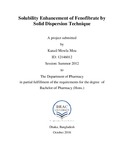| dc.contributor.advisor | Kabir, Dr. Eva Rahman | |
| dc.contributor.author | Mou, Kanzil Mowla | |
| dc.date.accessioned | 2018-02-06T10:28:30Z | |
| dc.date.available | 2018-02-06T10:28:30Z | |
| dc.date.copyright | 2017 | |
| dc.date.issued | 2017-10-07 | |
| dc.identifier.other | ID 12146012 | |
| dc.identifier.uri | http://hdl.handle.net/10361/9408 | |
| dc.description | This project report is submitted in partial fulfilment of the requirements for the degree of Bachelor of Pharmacy, 2017. | en_US |
| dc.description | Cataloged from PDF version of project report. | |
| dc.description | Includes bibliographical references (page 52-54). | |
| dc.description.abstract | Solubility of drug is an imperative factor in case of oral drug delivery system to acquire intended drug concentration in systemic circulation in order to attain an efficacious therapeutic response. One of the major hindrances with formulation development of new chemical entities is poor aqueous solubility of drug. Despite of many techniques available to improve the solubility of poorly soluble drugs, it is very challenging to overcome all barriers that encounter solubility problems. The aim of the present study was to enhance the solubility of a lipid lowering agent, fenofibrate by solid dispersion which is considered as a potential method of increasing the solubility of poorly soluble drugs. The experiment was designed to obtain nine different formulations of solid dispersed fenofibrate with the combination of β-cyclodextrin and a hydrophilic carrier, PEG 6000 in different ratios to evaluate which ratio yielded better solubility. A comparative in-vitro dissolution study of fenofibrate was also performed in pure water and with 0.025M sodium lauryl sulphate in pure water in order to identify the drug release rate. In addition, saturation solubility study of fenofibrate was successfully done to minimize the unnecessary use of solvent. Afterwards, a 32 full factorial design was applied to systematically optimize the drug release profile using Design Expert Software to achieve the optimum formulation. The data analysis of the response developed by the software proved that different ratio of excipients has influence on dissolved percentage of drug. Finally, on the basis of desirability criterion and graphical representation, F6 was successfully selected as the optimum formulation, possessing better solubility. | en_US |
| dc.description.statementofresponsibility | Kanzil Mowla Mou | |
| dc.format.extent | 54 pages. | |
| dc.language.iso | en | en_US |
| dc.publisher | BRAC University | en_US |
| dc.rights | BRAC University project reports are protected by copyright. They may be viewed from this source for any purpose, but reproduction or distribution in any format is prohibited without written permission. | |
| dc.subject | Solubility enhancement | en_US |
| dc.subject | Solid dispersion | en_US |
| dc.subject | Fenofibrate | en_US |
| dc.title | Solubility enhancement of fenofibrate by solid dispersion technique | en_US |
| dc.type | Project report | en_US |
| dc.contributor.department | Department of Pharmacy, BRAC University | |
| dc.description.degree | B. Pharmacy. | |

